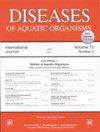Comparison of five commercial kits for isolation of total RNA in samples of WSSV-infected shrimp
IF 1.1
4区 农林科学
Q3 FISHERIES
引用次数: 0
Abstract
Viral diseases are the most serious threat to the expansion and development of shrimp aquaculture. Rapid diagnosis of the white spot syndrome virus (WSSV), a lethal shrimp pathogen, is essential to restrict its spread and reduce the mortality of infected shrimp. This virus has globally affected the shrimp farming industry, with a devastating economic impact. Several studies have focused on the expression of WSSV transcripts to understand the molecular mechanisms governing the pathological development of the disease. Since gene expression studies and molecular diagnostics at the early stages of infection depend on the efficient isolation of high-quality RNA, the extraction methods should be carefully selected. However, previous comparisons of the performance of RNA isolation kits have yet to be systematically investigated. In this study, 5 commercial RNA extraction methods were compared in WSSV-infected shrimp. The highest total RNA yield (ng mg-1 tissue) was obtained using TRIzol. Even though the 260/280 nm absorption ratios showed significant differences, the methods showed good purity values (>2.0). RNA integrity was evaluated in a denaturing agarose gel electrophoresis, and degradation was observed after the total RNA samples were treated with DNase I. Finally, the method that allowed the earlier detection of WSSV transcripts by qRT-PCR was the Zymo Direct-zol RNA MiniPrep kit. This study shows that the amount of observed (or estimated) WSSV transcripts might be affected because of the RNA isolation method. In addition, these results may contribute to improve the accuracy of the results obtained in gene expression studies, for more sensitive and robust detection of WSSV.5种商用试剂盒对感染wssv的虾样品中总RNA的分离比较
本文章由计算机程序翻译,如有差异,请以英文原文为准。
求助全文
约1分钟内获得全文
求助全文
来源期刊

Diseases of aquatic organisms
农林科学-兽医学
CiteScore
3.10
自引率
0.00%
发文量
53
审稿时长
8-16 weeks
期刊介绍:
DAO publishes Research Articles, Reviews, and Notes, as well as Comments/Reply Comments (for details see DAO 48:161), Theme Sections and Opinion Pieces. For details consult the Guidelines for Authors. Papers may cover all forms of life - animals, plants and microorganisms - in marine, limnetic and brackish habitats. DAO''s scope includes any research focusing on diseases in aquatic organisms, specifically:
-Diseases caused by coexisting organisms, e.g. viruses, bacteria, fungi, protistans, metazoans; characterization of pathogens
-Diseases caused by abiotic factors (critical intensities of environmental properties, including pollution)-
Diseases due to internal circumstances (innate, idiopathic, genetic)-
Diseases due to proliferative disorders (neoplasms)-
Disease diagnosis, treatment and prevention-
Molecular aspects of diseases-
Nutritional disorders-
Stress and physical injuries-
Epidemiology/epizootiology-
Parasitology-
Toxicology-
Diseases of aquatic organisms affecting human health and well-being (with the focus on the aquatic organism)-
Diseases as indicators of humanity''s detrimental impact on nature-
Genomics, proteomics and metabolomics of disease-
Immunology and disease prevention-
Animal welfare-
Zoonosis
 求助内容:
求助内容: 应助结果提醒方式:
应助结果提醒方式:


